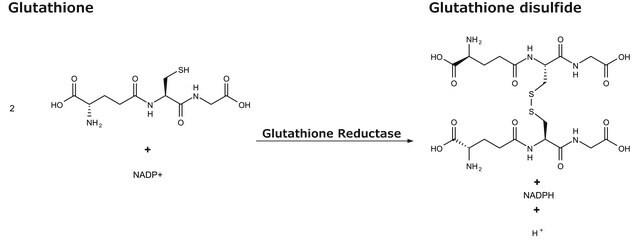CS0260
Glutathione Assay Kit
sufficient for 700 assays
Synonym(s):
GSH Quantification Test
Sign Into View Organizational & Contract Pricing
All Photos(2)
About This Item
UNSPSC Code:
12161503
NACRES:
NA.84
Recommended Products
General description
The kit provides all reagents for simple and quick assay to measure the level of total glutathione (GSSG + GSH) in a cell and tissue extracts and in red blood cells or plasma. The sample is first deproteinized with the 5% 5-sulfosalicylic acid solution. Glutathione content of the sample is then assayed using a kinetic assay in which catalytic amounts of glutathione cause a continuous reduction of 5,5′-dithiobis-(2-nitrobenzoic) acid (DTNB) to TNB. The oxidised glutathione formed is recycled by glutathione reductase and NADPH. The product, TNB, is assayed colorimetrically at 412 nm.
Application
Glutathione Assay Kit has been used to measure total glutathione concentration in glutathione assay. It also has been used to determine different oxidative stress parameters in rats.
Biochem/physiol Actions
Glutathione (GSH) functions as a cofactor for several antioxidant enzymes. It is involved in the regeneration of vitamins C and E. It modulates cellular proliferation and apoptosis. GSH is crucial for mitochondrial functioning and the maintenance of mitochondrial DNA (mtDNA). Mutations in this gene are associated with Alzheimer′s, Parkinson′s and Huntington′s diseases. It is also linked to cystic fibrosis, immune diseases and cardiovascular diseases.
Reduced glutathione (GSH), a tripeptide (g-glutamyl-cysteinylglycine), is the major free thiol in most living cells and is involved in many biological processes such as detoxification of xenobiotics, removal of hydroperoxides, and maintenance of the oxidation state of protein sulfhydryls. It is the key antioxidant in animal tissues
Features and Benefits
- A quick and simple method
- The kit contains all the reagents required for a colorimetric assay of total glutathione (oxidised + reduced GSSG + GSH)
- The kit includes a deproteination reagent for biological samples
Kit Components Only
Product No.
Description
- Assay Buffer 5x 30 mL
- DTNB 8 mg
- DMSO 7.5 mL
- Glutathine Reductase 20 U
- L-Glutathione Reduced 300 μg
- NADPH 25 mg
- 5-Sulfosalicylic Acid 2.5 g
related product
Product No.
Description
Pricing
Signal Word
Danger
Hazard Statements
Precautionary Statements
Hazard Classifications
Eye Dam. 1 - Resp. Sens. 1 - Skin Corr. 1B
Storage Class Code
8A - Combustible corrosive hazardous materials
Flash Point(F)
188.6 °F
Flash Point(C)
87 °C
Choose from one of the most recent versions:
Already Own This Product?
Find documentation for the products that you have recently purchased in the Document Library.
Customers Also Viewed
Metallothionein-1G facilitates sorafenib resistance through inhibition of ferroptosis
Sun X, et al.
Hepatology, 64(2), 488-500 (2016)
Role of thiol-complex formation in 2-hydroxyethyl- methacrylate-induced toxicity in vitro
Samuelsen,J et al.
Journal of Biomedical Materials Research, 96A, 385-401 (2011)
Mechanisms underlying differential response to estrogen-induced apoptosis in long-term estrogen-deprived breast cancer cells
Sweeney EE, et al.
International Journal of Oncology, 44(5), 1529-1538 (2014)
Zhanhui Ou et al.
Reproductive biology and endocrinology : RB&E, 18(1), 55-55 (2020-05-29)
The effects of cigarette smoking on male semen quality are controversial, and the molecular mechanisms underlying how cigarette smoking affects semen quality are not clear yet. In this study, semen samples from 70 heavy smokers and 75 non-smokers receiving infertility
Maria Swastika et al.
Malaria journal, 19(1), 208-208 (2020-06-20)
Glucose-6-phosphate dehydrogenase (G6PD) deficiency is the most common enzyme disorder in the world. Its main function is to generate NADPH that is required for anti-oxidative pathway in the cells especially in red blood cells (RBC). G6PD deficiency is X-linked and
Our team of scientists has experience in all areas of research including Life Science, Material Science, Chemical Synthesis, Chromatography, Analytical and many others.
Contact Technical Service






